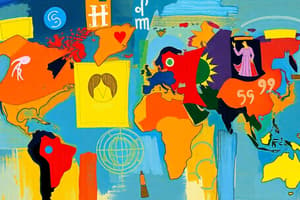Podcast
Questions and Answers
What is the significance of managers perceiving and responding to the organizational environment effectively?
What is the significance of managers perceiving and responding to the organizational environment effectively?
It is crucial for managerial success as it helps navigate uncertainties and make informed decisions.
How do the global task and general environments differ?
How do the global task and general environments differ?
The global task environment consists of specific forces like suppliers and customers, while the general environment includes broader factors such as economic and political conditions.
What challenges do the forces in the global task environment present to organizations?
What challenges do the forces in the global task environment present to organizations?
They create unpredictability and require managers to constantly adapt strategies related to supply chain and customer interactions.
Why is globalization increasing the competitiveness of the global environment?
Why is globalization increasing the competitiveness of the global environment?
What role do technological forces play in shaping the general global environment?
What role do technological forces play in shaping the general global environment?
What factors contribute to differences in national cultures, and why is this significant for global managers?
What factors contribute to differences in national cultures, and why is this significant for global managers?
How do demographic forces affect the global business environment?
How do demographic forces affect the global business environment?
Explain the importance of global outsourcing in modern business practices.
Explain the importance of global outsourcing in modern business practices.
How can the bargaining position of suppliers influence a manager's procurement strategy?
How can the bargaining position of suppliers influence a manager's procurement strategy?
What are the potential consequences of having powerful distributors in the marketplace?
What are the potential consequences of having powerful distributors in the marketplace?
Explain the impact of high rivalry among competitors on an organization’s profitability.
Explain the impact of high rivalry among competitors on an organization’s profitability.
Identify the importance of recognizing potential competitors in the task environment.
Identify the importance of recognizing potential competitors in the task environment.
How does customer identification contribute to organizational success?
How does customer identification contribute to organizational success?
What role do barriers to entry play in shaping market competition?
What role do barriers to entry play in shaping market competition?
Discuss how brand loyalty can affect an organization's market strategy.
Discuss how brand loyalty can affect an organization's market strategy.
What strategies can managers use to respond to supplier power in the global marketplace?
What strategies can managers use to respond to supplier power in the global marketplace?
What are economies of scale and how do they benefit large organizations?
What are economies of scale and how do they benefit large organizations?
How do government regulations act as barriers to entry in various industries?
How do government regulations act as barriers to entry in various industries?
Identify two economic forces that can influence the health of an organization.
Identify two economic forces that can influence the health of an organization.
In what ways do technological forces affect production and distribution in businesses?
In what ways do technological forces affect production and distribution in businesses?
How does the social structure of a society influence business operations?
How does the social structure of a society influence business operations?
Describe the significance of national culture in relation to business practices.
Describe the significance of national culture in relation to business practices.
What demographic changes are industrialized nations experiencing that affect their labor markets?
What demographic changes are industrialized nations experiencing that affect their labor markets?
How can changes in policies regarding environmental protection impact business operations?
How can changes in policies regarding environmental protection impact business operations?
How do cultural values influence social norms within a society?
How do cultural values influence social norms within a society?
What distinguishes mores from folkways in a cultural context?
What distinguishes mores from folkways in a cultural context?
Explain the significance of Hofstede's model of national culture in understanding global interactions.
Explain the significance of Hofstede's model of national culture in understanding global interactions.
What is the impact of individualism on societal values and norms?
What is the impact of individualism on societal values and norms?
How does power distance affect perceptions of inequality in a society?
How does power distance affect perceptions of inequality in a society?
In what ways do financial, human, resource, and institutional capital flow between countries?
In what ways do financial, human, resource, and institutional capital flow between countries?
Describe how national culture can affect business practices across different countries.
Describe how national culture can affect business practices across different countries.
What role does collective responsibility play in collectivist cultures?
What role does collective responsibility play in collectivist cultures?
How does Hofstede's Achievement Orientation differ from Nurturing Orientation in its worldview?
How does Hofstede's Achievement Orientation differ from Nurturing Orientation in its worldview?
What is the primary characteristic of societies with high Uncertainty Avoidance according to Hofstede's model?
What is the primary characteristic of societies with high Uncertainty Avoidance according to Hofstede's model?
Explain the difference in financial behavior between Long-Term Orientation and Short-Term Orientation cultures.
Explain the difference in financial behavior between Long-Term Orientation and Short-Term Orientation cultures.
Identify one cultural dimension from The Globe Project and describe a country that scored high on it.
Identify one cultural dimension from The Globe Project and describe a country that scored high on it.
What is meant by 'Institutional collectivism' as per The Globe Project?
What is meant by 'Institutional collectivism' as per The Globe Project?
How does Power Distance influence management practices in varying cultures?
How does Power Distance influence management practices in varying cultures?
What critical insight does Hofstede’s model provide regarding national culture and management effectiveness?
What critical insight does Hofstede’s model provide regarding national culture and management effectiveness?
Discuss how Gender Egalitarianism differs from Gender Differentiation in cultural perspectives.
Discuss how Gender Egalitarianism differs from Gender Differentiation in cultural perspectives.
Flashcards
Global Environment
Global Environment
The set of global forces and conditions that affect a manager's ability to acquire and utilize resources.
Task Environment
Task Environment
Forces stemming from suppliers, distributors, customers, and competitors that impact an organization's input and output.
General Environment
General Environment
Wide-ranging global, economic, technological, socio-cultural, demographic, political, and legal forces affecting an organization.
Global Outsourcing
Global Outsourcing
Signup and view all the flashcards
Suppliers
Suppliers
Signup and view all the flashcards
Customers
Customers
Signup and view all the flashcards
Competitors
Competitors
Signup and view all the flashcards
Managerial Success
Managerial Success
Signup and view all the flashcards
Global Suppliers
Global Suppliers
Signup and view all the flashcards
Distributor Power
Distributor Power
Signup and view all the flashcards
Competitor Rivalry
Competitor Rivalry
Signup and view all the flashcards
Potential Competitors
Potential Competitors
Signup and view all the flashcards
Customer Importance
Customer Importance
Signup and view all the flashcards
Barriers to Entry
Barriers to Entry
Signup and view all the flashcards
Brand Loyalty
Brand Loyalty
Signup and view all the flashcards
Economies of Scale
Economies of Scale
Signup and view all the flashcards
Government Regulations
Government Regulations
Signup and view all the flashcards
Technological Forces
Technological Forces
Signup and view all the flashcards
National Culture
National Culture
Signup and view all the flashcards
Demographic Forces
Demographic Forces
Signup and view all the flashcards
Political and Legal Forces
Political and Legal Forces
Signup and view all the flashcards
Globalization
Globalization
Signup and view all the flashcards
Four Types of Capital Flow
Four Types of Capital Flow
Signup and view all the flashcards
Cultural Values
Cultural Values
Signup and view all the flashcards
Mores
Mores
Signup and view all the flashcards
Folkways
Folkways
Signup and view all the flashcards
Individualism vs. Collectivism
Individualism vs. Collectivism
Signup and view all the flashcards
Power Distance
Power Distance
Signup and view all the flashcards
Hofstede’s Model
Hofstede’s Model
Signup and view all the flashcards
Achievement Orientation
Achievement Orientation
Signup and view all the flashcards
Nurturing Orientation
Nurturing Orientation
Signup and view all the flashcards
Uncertainty Avoidance
Uncertainty Avoidance
Signup and view all the flashcards
Long-Term Orientation
Long-Term Orientation
Signup and view all the flashcards
Short-Term Orientation
Short-Term Orientation
Signup and view all the flashcards
Performance Orientation
Performance Orientation
Signup and view all the flashcards
National Culture and Global Management
National Culture and Global Management
Signup and view all the flashcards
The Globe Project
The Globe Project
Signup and view all the flashcards
Study Notes
Managing in a Global Environment - Chapter 4
- Learning Objectives:
- Understanding the importance of perceiving, interpreting, and responding effectively to organizational environments for managerial success is crucial.
- Differentiating between global task and general environments is essential.
- Identifying key forces within both task and general environments, and assessing their challenges to managers.
- Explaining the increasing openness and competitiveness of the global environment and the forces of globalization.
- Analyzing the reasons behind national cultural variations and their significance in management.
Overview
- Global Organizations: Operate across multiple countries, facing uncertainty and unpredictability.
- Global Environment: A collection of global forces and conditions impacting an organization's ability to access and use resources. These conditions operate beyond an organization's boundaries but still affect their operations.
Forces in the Global Environment
-
General Environment: Factors affecting all organizations, including:
- Economic forces (interest rates, inflation, unemployment)
- Technological forces (technological advancements impacting organizational practices)
- Sociocultural forces (pressures from a country's social values and cultures)
- Demographic forces (outcomes of changes to population characteristics, like age and gender)
- Political and legal forces (laws and regulations)
-
Task Environment: Direct interactions with competitors, suppliers, distributors, and customers, influencing organizations’ activities daily.
What is the Global Environment?
- Task Environment: Forces related to suppliers, distributors, customers, and competitors that affect an organization's ability to get inputs and sell its outputs..These interactions and relationships have a direct impact on daily decision-making.
- General Environment: Factors like technology, economics, politics, culture, demographics, and legal systems impacting an organization and its immediate environment.
The Task Environment
- Suppliers: Individuals or organizations providing resources like raw materials, components, and labor to an organization.
- Distributors: Organizations facilitating the sale of goods and services, connecting businesses with customers.
- Customers: Individuals or groups acquiring goods/services from an organization, critical for success.
- Competitors: Organizations offering similar goods/services, driving price competition, and affecting profitability.
- Potential Competitors: Organizations not currently in the task environment but potentially entering the market.
Barriers to Entry and Competition
- Economies of Scale: Cost advantages from large-scale operations.
- Brand Loyalty: Customer preference for established brands acting as a barrier.
- Government Regulations: Legal restrictions on entry/operation impacting market competition.
The General Environment
- Economic Forces: Factors like interest rates, inflation, unemployment influencing an organization’s operations.
- Technological Forces: Impacts of technology on design, production, and distribution of products/services.
- Sociocultural Forces: Pressures related to a society's values, beliefs, and behaviors, affecting decision-making.
- Demographic Forces: Outcomes of changes in the characteristics of a population (e.g., age, gender, ethnicity).
- Political and Legal Forces: Laws and regulations impacting organizations.
The Changing Global Environment – Globalization
- Globalization involves integrating economic, political, and social systems worldwide, increasing interdependence.
- Forms of capital flows include human, financial, material (resources), and political resources.
The Role of National Culture
- Values: Societal beliefs about what is good, desirable, and beautiful.
- Mores: Central norms essential to a society's functioning.
- Folkways: Routine social customs.
- Hofstede's Model: Dimensions of national culture (Individualism/Collectivism, Power Distance, Uncertainty Avoidance, Masculinity/Femininity, Long-Term/Short-Term Orientation).
- The GLOBE Project: Nine dimensions (Performance Orientation, Assertiveness, Future Orientation, Human Orientation, Institutional Collectivism, In-Group Collectivism, Gender Egalitarianism, Power Distance, Uncertainty Avoidance)
National Culture and Global Management
- Effective management practices in one country might not be effective in others.
- Managers must be sensitive to value systems and norms when dealing with international operations.
Studying That Suits You
Use AI to generate personalized quizzes and flashcards to suit your learning preferences.




